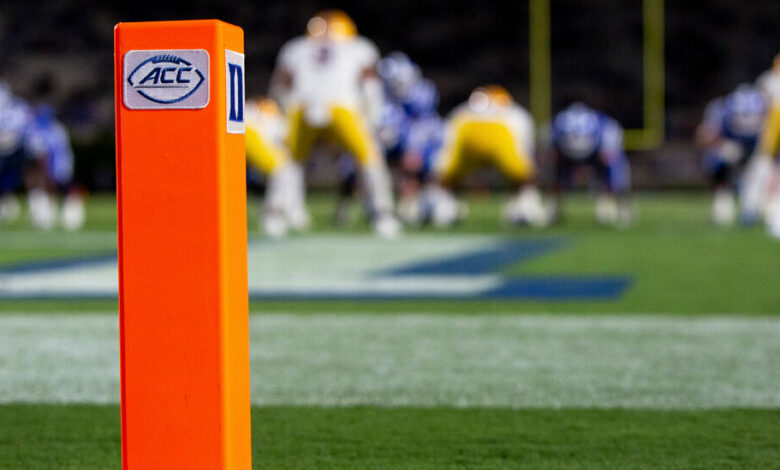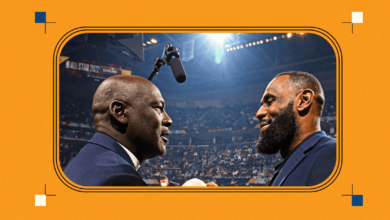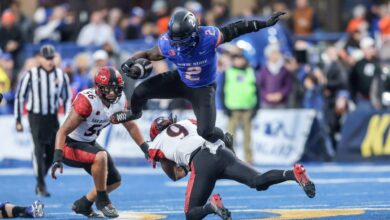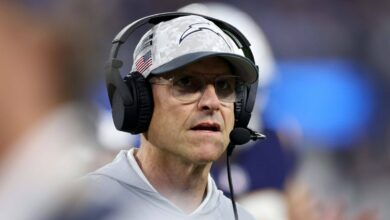Conferences change. So does sports.

When the college football season kicks off in earnest this Labor Day weekend, keeping your eye on the ball will be a test. The focus for a few days might be on blocking, tackling and quick assessments of who’s above and who’s below, but what then in a sport on the cusp of unprecedented upheaval?
Think about what American football will look like a year from now.
The Pac-12 Conference may not exist. Texas and Oklahoma, the anchors of the Big 12 Conference, will be in the Southeastern Conference. The Atlantic Coast Conference will ultimately be bicoastal after Friday’s agreement to add California-Berkeley and Stanford along with Southern Methodist as new rivals to Duke and North Carolina.
And after this season, the College Football Playoff will go from four teams to 12.
This is happening at a time when the movement of schools, fueled by television money, is exceeded only by the movement of players, whose program hopping is fueled by money from booster-funded collectives now allowed under NCAA rules.
Structural changes may also be imminent. There are cases in federal court and the National Labor Relations Board asking for athletes to be considered employees to whom wages and benefits are owed. There are competing bills in Congress that seek to protect the interests of athletes or schools (perhaps each other), and a bill in the California Legislature that would require universities to share sports revenue with athletes.
Meanwhile, the Internal Revenue Service is raising questions about collectives masquerading as charities.
“This is the highest level of distraction in the history of sports,” said Michael LeRoy, who teaches sports labor law at the University of Illinois Urbana-Champaign. “It doesn’t matter if you’re an athlete, a coach, an athletic director or a university president, there’s always something to distract you from.”
Not surprisingly, the big business of college athletics is at the heart of this unrest.
The widening income gap in the sector has sharpened the divide between the ‘haves’ and the ‘have-nots’. (Ohio State reported $252 million in athletic department revenue last year, nearly ten times that of its neighbor, Ohio University.)
Stanford, Cal and SMU were so eager to join the ACC that they did so at a significant discount. Stanford, which wanted to cut 11 sports as a cost-cutting measure during the pandemic, and Cal, which needed a $31 million campus grant last year to keep its athletics department out of the red, will agree to the agreement, according to a person familiar with the agreement. claiming only 30 percent of the ACC’s average media rights distribution for the first seven years. (The ACC distributed $39.4 million per school last year, with just over half coming from the TV rights deal with ESPN.)
Under the deal approved in a vote by ACC university presidents, SMU will not receive media rights for seven years, said the person, who spoke on condition of anonymity because they were not authorized to disclose details. Still, SMU, which tried to join the Pac-12 earlier this year, is eager to move up the food chain. It will leave the American Athletic Conference, whose football-driven media rights deal earns its schools about $7 million a year.
Last year, the so-called Power 5 conferences, the Big Ten, SEC, Big 12, ACC and Pac-12, generated a combined total of $3.3 billion, according to tax returns obtained by USA TodayThe richest programs, whose last source of revenue is partnerships with gambling companies that have brought their own problems, pour so much money into facilities, amenities and coach salaries that calls for revenue sharing with players are now coming from a previously unlikely source: coaches.
Michigan State football coach Jim Harbaugh read a long prepared statement at a news conference this week in which he called revenue sharing with athletes a moral imperative. “When student-athletes call it a game, corporate types call it a business,” Harbaugh said. “When the student-athletes call it a business, the corporate types call it a game.”
College athletics has always distinguished itself from professional sports in this way, relying on its connection to higher education. And yet, as football and some other college sports increasingly resemble a professional model, their connection to the educational mission of nonprofit, largely public universities has become increasingly tenuous.
However, college athletics differs from the professional model in at least one way. Professional sports leagues in North America are essentially socialist structures for billionaires, with various forms of revenue sharing, spending caps or taxes, and milking of public resources so that no team can be mismanaged and go bankrupt. (See Oakland athletics.)
College athletics is increasingly looking like an unregulated capitalist free-for-all movement.
Texas and Southern California, where football teams’ television ratings have largely surpassed their on-field records over the past decade, jumped ship after their pleas for a bigger cut in conference revenue were rejected. The state of Florida has similarly complained about leaving the ACC unless it gets more revenue. Oklahoma trailed rival Oklahoma State, effectively ending their football series that had been played every year since its inception in 1904.
A year ago, the Big Ten Conference, working with its corporate partner Fox, hastened the demise of the Pac-12, its Rose Bowl partner since 1946, when it poached USC and UCLA. And in the time since, Big 12 commissioner Brett Yormark has advocated breaking up the Pac-12 until it came to that, hoping it would allow his conference to expand westward.
“This has become a soulless business,” LeRoy said. “There’s no moral compass. There’s no brotherhood. Now you’re eating off your brother’s plate and you don’t care if he’s hungry.”
While Oregon State and Washington State are talking to officials from the Mountain West and American Athletic Conferences about a landing spot, there’s no sign the consolidation is over. Just that it will pause.
Ultimately, university football can resemble English football, with promotion, relegation and a handful of big teams topping the table every year.
As Labor Day approaches, all that will be put aside, at least this weekend, in college football enclaves across the country. One of those is in Manhattan, Kansas, where Kansas State has won its first conference title in a decade and is ranked 16th in the Associated Press Top 25 poll, its highest ranking in the preseason poll since 2004. The availability of tickets for three Wildcats home games have been reduced to standing room only and fundraising has reached record highs.
“You can feel the energy,” said Kansas State athletic director Gene Taylor.
Still, he acknowledges that the season will feel different in other ways.
Kansas State will not play Oklahoma, which it has done nearly every year since 1919, and will host Big 12 newcomers Central Florida and Houston in conference play. The return next year of Colorado, a former member of the Big Eight (the predecessor to the Big 12), will bring some historical baggage back to the conference, which is adding eight teams this season and next.
The conference realignment has left Taylor uneasy about the burden of travel that Olympians must shoulder for far-flung conference games. But he’s not ready to join a growing number of people who are proposing that soccer be separated from other sports so that they can be reorganized geographically.
Where is this going?
“Boy, that’s a good question,” Taylor said, pausing before continuing. “When I see what’s happened, I tell our staff, ‘Don’t lock your knees. You’ve got to stay flexible.’ Look at what happened to the Pac-12 this summer. I didn’t see that coming. And I didn’t expect Texas and Oklahoma to go to the SEC. A couple years ago, we were the conference that was going to fall apart. Fortunately, we have a commissioner who has put us in a good position.”
At least for now.
It probably wouldn’t be hard for Taylor to look west and see a kindred spirit in Oregon State.
Throughout the 1970s and 1980s, Kansas State and Oregon State were ritually among the worst teams in the country — agricultural colleges isolated in small towns with few resources, little history of success and defeated fans. Eventually, they both found the right coach, Bill Snyder at Kansas State and Mike Riley at Oregon State, who helped them punch above their weight on a regular basis. They still do that.
Oregon State is in the same preseason rankings as Kansas State at No. 18, its highest to enter the season since 2001. The Beavers won 10 games last season, added Clemson transfer DJ Uiagalelei at quarterback and have a favorable enough conference schedule — they don’t play USC and won’t host Utah, Washington and UCLA in their newly renovated home stadium — that they could emerge as a playoff dark horse.
It would be a special moment for the state of college football: a team seeking a national championship and a place to call home.




